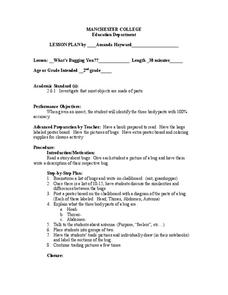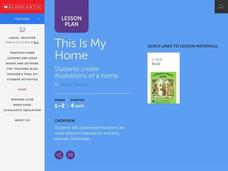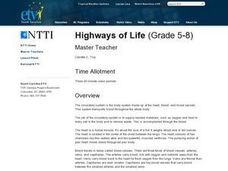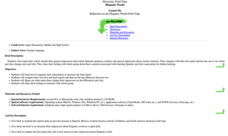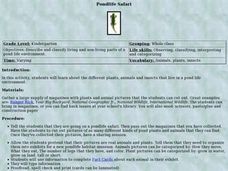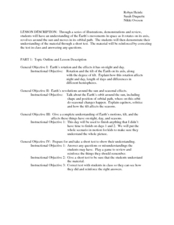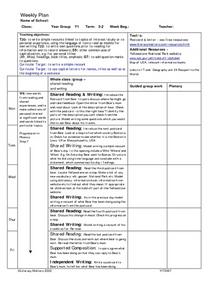Curated OER
Exploring War Themes in Art and Poetry
What is war? Students discuss the ethical dilemma of war by viewing Picasso's painting entitled "Guernica" and write down everything they see in the painting. Then they choose one emotion that best summarizes their emotional response to...
Alabama Learning Exchange
How Old Is That Tree?
Fifth graders study environmental changes by examining the annual rings of a cross-section of a tree trunk. They access websites to complete a worksheet on the parts of a tree. They count the annual rings on a tree slice while observing...
Curated OER
Mental Images in Reading Comprehension
Students use textual clues to create mental images and interpret characters moods and actions. They visualize the setting, characters and events.
Curated OER
Quicksand Questions: Short In-class Activity
Students are prompted with questions during a lecture on quicksand. Student answers can be collected with classroom response systems. The responses (both individual and the class as a whole) are recorded on the instructor's computer....
Curated OER
Seedfolks
Students explore sequencing. In this sequencing lesson, students sequence events to analyze character actions as cause and effect or the plot of the story. Students discuss character actions and list them on a chart.
Curated OER
Equal Parts
In this equal parts worksheet, students, working with a partner, study, formulate and calculate the answers to six word problems or drawings.
Curated OER
Study Buddies: Working With Fractions
In this math worksheet, students will work with a coach to solve a fractions story problem. Students will follow a step-by-step process and notes are provided for the coach.
Curated OER
My Brother Sam is Dead: A study of the Revolutionary War
Fifth graders complete an analysis of the Revolutionary War through literature. After "My Brother Sam Is Dead," students create a time capsule containing items that would be relevant during the Revolutionary War. They identify key...
Curated OER
What's Bugging You?
Second graders investigate insects. In this parts of a whole, 2nd graders discuss what the three body parts of an insect are as well as the antenna. Students create their own insect labeling each body part and antenna.
Curated OER
What is a Fraction
Students explore fractions and define their parts. They define numerator and the denominator and use an apple to model familiar fractions. Using, mini whiteboards, they draw pictures on their white board to describe a given fraction.
Curated OER
This Is My Home
Students listen to a read aloud of Mary Ann Hoberman's A House Is a House for Me before discussing the meaning of habitats and the different types of homes that people live in. Next, they pretend to be architects and design a home for...
Curated OER
Ancient Farmers of the Amazon
Students read a sample research proposal and create their own. They discover the type of information needed for others to reject or accept the proposal. They practice applying the scientific process to different situations.
Curated OER
Highways of Life
Students explore the circulatory system. They participate in media activities to explore blood flow and identify the parts of the circulatory sytem. Students create a model of the circulatory system.
Curated OER
A Royal Charter From the King
Fifth graders explore the many decisions that early colonist had to make when coming to North America. In this royal charter lesson plan, 5th graders work in teams to create a proposal for the King of England to establish a new colony in...
Curated OER
Science Lessons for Grade 8
Eighth graders identify the symptoms and causes of diabetes. In this biology lesson, 8th graders demonstrate how urine testing is used to diagnose illness. They explain why some metals are more reactive than others.
Curated OER
Hispanic World - Lesson Six
Students explore a Spanish speaking country and compare their research to their initial expectations and biases regarding the Hispanic culture. They share their findings with the class.
Curated OER
Truth and Advertising
Young scholars view and analyze fragments of advertising images from magazines to become familiar with different techniques used to sell products, write captions for advertisements, and create their own advertisements from scratch based...
Curated OER
The Fabulous Four
First graders examine the four seasons and identify appropriate attire for various seasonal activities. They listen to various books about each season, identify activities for each season, draw a picture of their favorite parts of the...
Alabama Learning Exchange
Making and Observing Life in a Terrarium
Young scholars understand the parts of the terrarium and why they are important in establishing an ecosystem. In this ecosystem lesson, learners recall background information on aquariums, terrariums and the water cycle. Young scholars...
Curated OER
Pond-life Safari
Students determine the living and non-living parts of pond life. In this pond life lesson plan, students examine the plants, animals, and insects that live in ponds. They look through a variety of print media, cut out pictures, and...
Curated OER
Earth's Movement in Space
Students explain how the Earth's tilt and rotation causes night and day. In this earth science lesson, students determine how seasonal changes are caused by Earth's revolution. They play a jeopardy team game at the end of the unit to...
Curated OER
"Postcard From Bear"
Students complete various activities related to the book "Postcard From Bear." They participate in a shared reading activity, identify the locations in the book on a map, and write a postcard to the bear in the story.
Curated OER
Organ Systems
Students state the name of major body systems, They identify what each system does and list the major organs in each system. In addition, they complete a puzzle matching organ systems to organ function.
Curated OER
Worksheet-Scale Drawing-Unit One
In this scale drawing worksheet, students find the area of a compound shape. Students are presented with a drawing of two different sized rectangles that share one side. They compute the size of each rectangle and add their areas...








